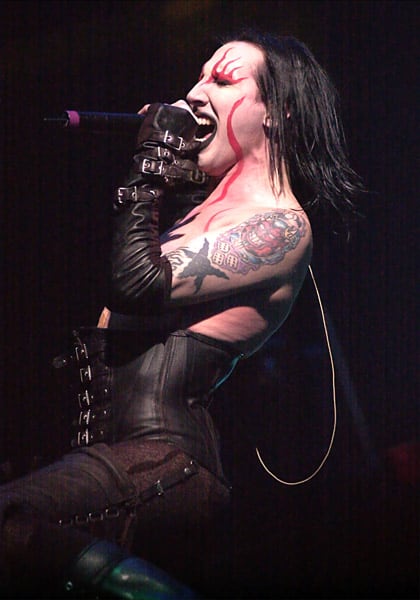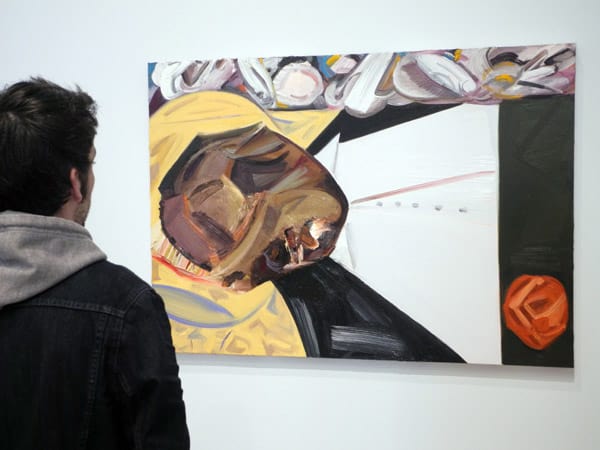Anti-Racism: The Politics of Personal Holocaust
Chris Roberts, American Renaissance, August 4, 2017
When I was growing up, “emo” was all the rage among white kids. For teenagers who weren’t good at sports, didn’t like hip-hop, and weren’t well adjusted enough simply to be nerds, emo was their niche. Short for “emotional,” being emo meant having feelings: being too sensitive for the big, cruel world.
What I saw in the emo mind gave me real insight into the otherwise incomprehensible mentality of white “anti-racists.”
Emo kids wore tight-fitting black clothes and gobs of black eyeliner, especially the girls. They read books about isolated and unhappy teenagers, such as Catcher in the Rye and The Perks of Being a Wallflower. As with all adolescents, a particular genre of music was a big part of being emo. My Chemical Romance, Death Cab for Cutie, Panic! At The Disco, and Hawthorne Heights were the bands that defined the emo ethos of navel-gazing, tear-jerking angst:
And I can’t make it on my own.
So cut my wrists and black my eyes.
So I can fall asleep tonight, or die.
Because you kill me.
You know you do, you kill me well.
You like it too, and I can tell.
You never stop until my final breath is gone.
And:
I won’t explain or say I’m sorry
I’m unashamed, I’m gonna show my scars
Give a cheer for all the broken
Listen here, because it’s who we are
I’m just a man, I’m not a hero
Just a boy, who had to sing this song
I’m just a man, I’m not a hero
I don’t care
This is a far cry from the usual love-sick pop lyrics and even from celebrations of drug-taking and the thug life.

Guitarist from My Chemical Romance. (Credit Image: Joel Auerbach/ZUMAPRESS.com)
If you remember news stories from the early and mid-2000s about legions of teens suddenly cutting themselves, that was the era of the emo. Cutting was generally not meant to end in suicide. It was just a way for emos to express the angst raging inside. In the world of emo, dysfunctionality and sadness were points of pride. The world was an evil place, and only bad people could be happy in it. The less you could handle, the more virtuous you must be. In emo circles, this led to a race to the bottom in terms of misery. The bottom was usually cutting and sometimes suicide.
While often confused with the equally white “goth” subculture of the late 1990s, emo and goth were different. Though both trafficked in androgyny, dark clothing, and an “anti-jock-and-cheerleader” pose, there was a fundamental difference in attitude. Goths pointed all their rage and angst outward, while emos pointed it inward. Goth music tended to be about vengeance, not victimhood. Marilyn Manson, arguably the most famous goth musician, summed it up in his very popular “Fight Song:”
But I’m not a slave to a god
That doesn’t exist
And I’m not a slave to a world
That doesn’t give a shitFight! Fight! Fight! Fight!
Fight! Fight! Fight!

Marilyn Manson. (Credit Image: Steven Tackeff/ZUMAPRESS.com)
People worried that emo culture was leading teens to suicide, and that goth culture was causing school shootings. Indeed, the small number of goths I knew were comfortable with violence; some even reveled in it. Emos, on the other hand, were notoriously passive and out of shape. The joke was:
Emos hate themselves
Goths hate everyone
Emos want to kill themselves
Goths want to kill everyone
Trappings and music aside, goth was never much different from other youth cultures. Goths were angry, wanted to be unique, and wanted to change an unjust world. Like nearly every other youth fad, goths often expressed all of this in sloppy, uncouth, sophomoric ways.
Emos, on the other hand, never seemed interested in changing anything. While the angst and ennui they felt was ostensibly caused by how monstrous the world was, emos never talked about that monstrous world; only about their angst and ennui. Whatever problems the world might have — starvation, war, natural disaster, etc. — were only pretexts for moaning that “the world doesn’t understand me.” Emos didn’t want to save the world; they just wanted to agonize about how it couldn’t be saved. Unlike well intentioned hippies or Christians, emos never volunteered for local charities or Green Peace. They were more likely to stay at home in their rooms listening to their depressing music and crying over unrequited love.
Emo became an incubator for everyone’s personal holocaust. It was an excuse to do nothing with your life. Lying in bed all day instead of exercising, doing homework, or socializing was not only justifiable, but fashionable. It showed the kind of misery and depression that all good people should feel in our evil world. Putting no work at all into a romantic relationship — and having it end because of that — was just as fashionable. Destructive relationships that end poorly are only natural; only mindless boobs avoid the isolation inherent in the human condition. The logical endpoint was self-harm and sometimes suicide.
The byproduct of this was an almost complete absence of byproducts. Emos were so myopic, lazy, and self-pitying, that they didn’t create much of anything. There were a few big emo bands, a fleeting fashion sense, and perhaps a book or two, but they spent too much time navel-gazing to create anything. Little of that anemic output is remembered today, even just a decade or so after the emo peak. Endless volumes of cultural analysis and critique have been written about punk, mods, metal, hippies, even hip hop, but not about emo, because it never got around to creating much of anything, much less doing anything.
I bring up emo because it is so similar to the thinking of today’s white anti-racists. The biggest similarity is the underlying perspective: “The world is so vile and unjust that if you’re not tormented by it, you must be part of the reason it’s vile and unjust.” Emos never defined what the great injustices were, which meant they could never be resolved, and this conveniently justified perpetual agony. Many of today’s whites have likewise defined the great injustice of the world as whiteness itself, which conveniently condemns them to eternal agony over their own culpability.
The thinking is the same, in that the enemy is so big, ferocious, and widespread that victory is impossible. Knowing you face unconquerable evil is psychologically unhealthy. It guarantees hopelessness and depression. Just like the depression that sets in when an alcoholic tells himself he cannot overcome his addiction and that it is just the way he is, a man with no fighting spirit becomes capable of most anything. He can direct his depression inwards towards self-harm or suicide, or he can become permanently angry, and capable of violent outbursts towards both strangers and those who love him. All this is fueled by self-loathing.
People often see the aggressiveness of white anti-racists towards strangers, but do not realize that they treat each other just as viciously. Leftists on Twitter are constantly fighting — just check Susan Sarandon’s feed for the latest round — and gatherings of leftists often degenerate into finger pointing. One ex-leftist wrote of his hard-left anarchist days:
Affinity meetings that were once hotbeds of dissent began to seem more like kangaroo courts. Arguments began to spring from the nascent well of discontent, and “accountability” hearings were the new norm, a process more often than not designed to elucidate the accused’s latent homophobia or racism. Arguments against the state were shelved more often than not in favor of presentations on a seemingly endless parade of ‘passive’ social injustices . . . .
[Anti-racism] was understood to be innate to our shared ideology, and therefore our collective will could be focused and our mutual intent had been decided. This formed the basis for an arguably unified front that could be assembled and directed at will. But this mutual understanding was being corroded by a new, pernicious force that had infested every corner of the space. Anti-fascist organizers were no longer satisfied by directing their ire towards governmental institutions or hate groups and instead turned the looking glass inward. . . . Special privileges to be heard were conferred to the most oppressed within the group. This led to a bizarre new struggle within the movement over who might lay claim to being the most truly oppressed. The left was consumed by this new drive to expose the innate bigotry of the majority, especially within our own sphere. Where activists were once excommunicated over allegations of collusion with the authorities, they were now cast out frequently by accusations of complacent prejudice.
The author explains the white anti-racist mindset: virtue derives from oppression. Without oppression, there can be no virtue, so once you view whites as impossible to oppress, they become virtueless. You want to feel downtrodden and belittled, because that is the state of the truly virtuous.
The leftist critic Freddie deBoer wrote about this in a widely read piece for the Washington Post called, “Admitting that white privilege helps you is really just congratulating yourself.” He noted how self-satisfied and smug whites who confess their privilege always seem to be:
[B]y showily demonstrating their willingness to condemn themselves, these white people really seek to condemn the white people who don’t. The unspoken but unmistakable logic is that by declaring themselves a part of the problem, they are defining themselves as part of the solution.
He accurately notes the hypocrisy of white anti-racists: They love to feel good about themselves by feeling bad about being white. They carry around with them the terrible oppression of their consciousness of white privilege, and this self-imposed oppression makes them virtuous.
But Prof. deBoer does not stress enough the perversity of this logic. White anti-racists feel superior to other whites by confessing to a flaw they believe mars every white person everywhere. This is sick. To feel good, you have to feel bad. And you should feel bad if you feel good for any reason other than feeling bad. It’s like the emo kids whose misery was a sign of enlightenment.
And like emo culture, this self-obsessed, hyper-critical anti-racism creates almost nothing of interest. It produces a nearly endless stream of books, essays, blog posts, and Twitter rants about racism, microaggressions, and white privilege, none of which interests anyone outside obsessively anti-white-racist circles.
Creative art by white anti-racists is nearly impossible, as it always becomes a punching bag for more criticism. Consider the recent painting by a white anti-racist of Emmett Till, the black teenager lynched by whites in 1955. She painted Till because she thinks he is a martyr. But painting him — for whatever motive — spawned a ferocious debate among anti-racists over whether white people have the right to paint black martyrs at all.
Critics claimed that the painting was cultural appropriation. Any white who admired the painting was subconsciously evil, “co-opting” black suffering, regardless of the artist’s intent. This prompted a storm of anti-racist essays, blog posts, and Twitter rants. The only outsiders who paid any attention were a handful of conservatives who mocked it all as an example of leftist lunacy.

March 29, 2017 – New York, US – A visitor looks at the painting ‘Open Casket’ by artist Dana Schutz. The artwork inspired by a photo of Emmett Till has caused controversy in the world of art. (Credit Image: © Johannes Schmitt-Tegge/DPA via ZUMA Press)
When it comes to music, white anti-racists are obsessed with the alleged theft by white musicians of black music. This means they are hesitant to make any music themselves, lest they accidentally steal something. White anti-racists do, however, write about music: mostly about the thefts by various white artists and the unappreciated genius of black musicians such as Beyonce or Kanye West. One white rapper, Macklemore, has put out not one, but two cuts about this, literally called “White Privilege.” But mostly, this problem is taken up in books, essays, blog posts, and Twitter rants of no interest to outsiders.
Literature is similarly not possible for white anti-racists. They believe the world of letters is already too white. They constantly attack college curricula for being too white, and insist that portraits of white literary figures on campuses be taken down. I knew one anti-racist white girl in college who agonized about the children’s book she was writing. She believed children’s books needed more non-white characters, but as a white woman, she didn’t have the right to create non-white characters. A Google search reveals no published works.
There is a sick logic to this. Imagine wanting to write a novel, then deciding your vision is poisonous and should be suppressed or at least restrained. Imagine going back to the drawing board and deciding to write about something you believe isn’t poisonous, but then deciding that your own inherently poisonous nature would corrupt this otherwise pure subject. Of course, you’d abandon writing altogether.
This mental vicious cycle explains why deep anti-racism offers no way out. Once you have discovered the horrors of white privilege, what can you do about it? You scream at other whites who don’t realize they enjoy white privilege, but mostly you start on a long, futile “journey” of “working to overcome unconscious racism.” This means that mostly you scream at yourself, because you are white and can never overcome the crushing limits of being white.
This is like those sad emo kids. Such people are mentally disturbed. In today’s world, however, this kind of mental disturbance is considered perfectly fine so long as you attribute your poison to your race, and not to yourself as an individual.
Just like emo culture’s grip on depressed teens eager to justify their own self-obsessed internal angst, white anti-racism creates an environment of endless criticism and a total absence of artistic creation. White anti-racism is a politics of personal holocaust — an elaborate system of rules that ensure its adherents run in an eternal hamster wheel of fury and self-abnegation. All they have done is dress up emo self-hatred with grad-school jargon. And just like an alcoholic who’s stopped trying to be sober, their surrender often takes the form of lashing out at those around them.
I pity anti-racist whites more than I despise them. Their vitriol and violence are born from their own depression and self-hatred, not a coherent ideology. We would approach a family member in the throes of destructive depression with sympathy and compassion. We should approach our racial brethren who have fallen into this maniacal worldview the same way. They have nothing to lose but their own death wish.















